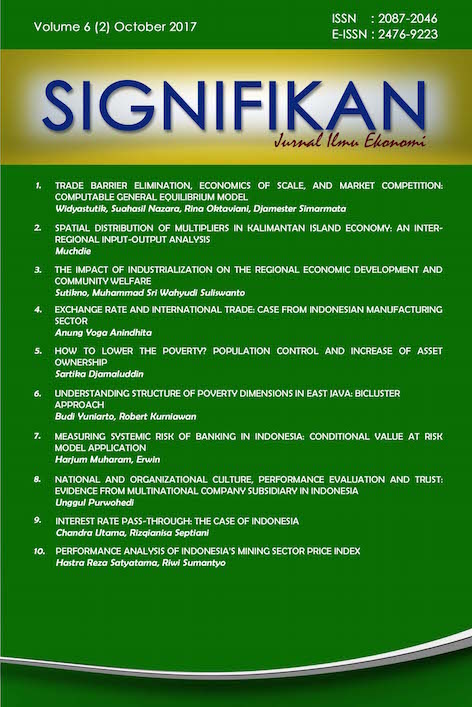Interest Rate Pass-Through: The Case of Indonesia
DOI:
https://doi.org/10.15408/sjie.v6i2.4819Keywords:
interest rate pass-through, interes rates, monetary policyAbstract
This paper examines the direct and indirect interest rate pass-trough (IRPT) from policy interest rate (BI rate) to banks’ retail interest rates in Indonesia during a full-fledged inflation-targeting regime. We use montly data of policy interest rate (BI rate) as well as interest rates for interbank money market (interbank), deposit, and loan during July 2005 to May 2015. We employ Error Correction Mechanism (ECM) and Ordinary Least Square (OLS) to find the significant of IRPT and the speed of adjustment process of IRPT. The study suggests the existence of direct and indirect IRPT in Indonesia. The change of policy rate is transmitted quicker in the direct channel compared to the indirect channel. However, indirect channel is more stable than the direct channel. We conclude that the direct and indirect IRPT are complementary.
References
Bank for International Settlements (BIS). (1994), National Differences in Interest Rate Transmission. March, Basle.
Borio, C.E.V. & W. Fritz. (1995). The Response of Short-term Bank Lending Rates to Policy Rates: a Cross-Country Perspective. BIS Working Paper No. 27.
Cottarelli, C. & A. Kourelis. (1994). Financial Structure, Bank Lending Rates, and The Transmission Mechanism of Monetary Policy. IMF Staff Papers 41: 587–623.
De Bondt, G. (2002). Retail Bank Interest Rate Pass-Through: New Evidence at The Euro Area Level. European Central Bank Working Paper Series No. 136.
Donnay, M. & H. Degryse. (2001). Bank Lending Rate Pass-Through and Differences in the Transmission of a Single EMU Monetary Policy. Discussion Paper, Center for Economic Studies, K.U. Leuven, 01.17.
Ếgert, B., J. Crespo-Cuaresma & T. Reinenger. (2006). Interest Rate Pass-Through in Central and Eastern Europe: Reborn from Ashes Merely to Pass Away? William Davidson Institute (The University of Michigan) Working Paper No. 851.
Grigoli, F., & J. Mota. (2015). Interest Rate Pass-Through in the Dominican Republic. International Monetary Fund.
Gujarati, D. N. & D. C. Porter. (2009). Basic Econometrics, 5th ed. New York. McGraw-Hill/Irwin.
Haughton, A. Y., & E. M. Iglesias. (2012). Interest Rate Volatility, Asymmetric Interest Rate Pass Through and The Monetary Transmission Mechanism in The Caribbean Compared to US and Asia. Economic Modelling. 29(6): 2071-2089.
Horváth, C., J. Kreko, & A. Naszodi. (2004). Interest Rate Pass-Through: The Case of Hungary. National Bank of Hungary Working Paper No. 8.
Sander, H., & S. Kleimeier. (2004). Convergence in Euro-Zone Retail Banking? What Interest Rate Pass-Through Tells Us About Monetary Policy Transmission, Competition and Integration. Journal of International Money and Finance. 23: 461–492.
Stanisławska, E. (2014) Interest Rate Pass-Through in Poland: Evidence from Individual Bank Data. Narodowy Bank Polski (NBP) Working Paper No. 179
Tai, N., K. Siok, & M. Wai. (2012). Interest Pass-Through and Monetary Transmission in Asia. International Journal of Economics and Finance. 4(2): 163-174.
Tang, M. M. J., C. H. Puah, & V. K. S. Liew. (2015). The Interest Rate Pass-Through in Malaysia: an Analysis on Asymmetric Adjustment. International Journal of Economics & Management, 9(2).
Utama, C., M. B. L. Wijaya, & C. Lim. (2017). The Role of Interest Rates and Provincial Monetary Aggregte in Maintaining Inflation in Indonesia. Buletin Ekonomi Moneter dan Perbankan. 19 (3): 267-286.
Wang, K.M. & M. Lee. (2009). Market Volatility and Retail Interest Rate Pass Through. Economic Modelling. 26:1270-1282.


